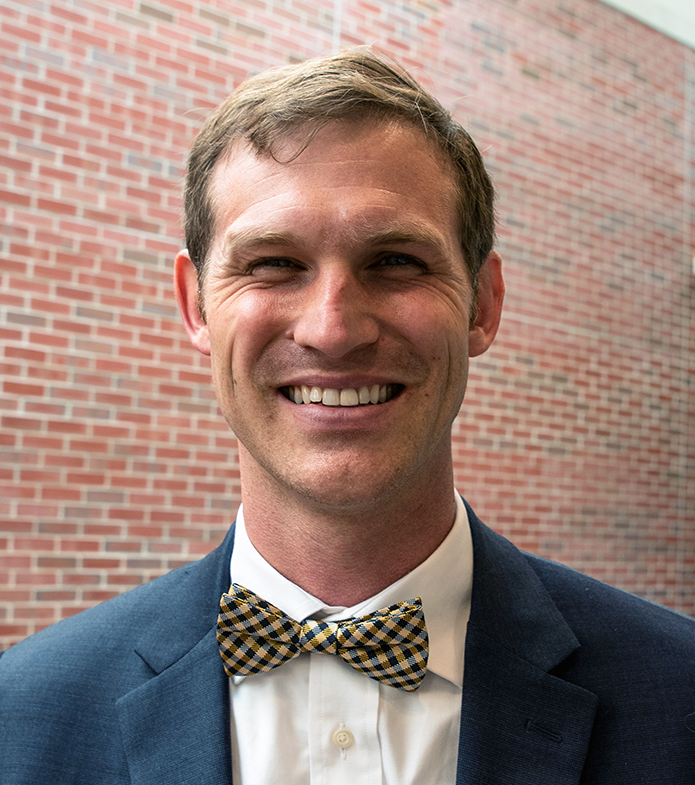
Research spotlight: Management insights from the Trulaske College of Business

Faculty in the Robert J. Trulaske, Sr. College of Business Management Department are examining relevant issues through data-driven, unbiased research that is informing and influencing today’s businesses and policymakers. Recent research has examined what motivates business leaders; how a firm’s political activity can impact potential employees; what type of leaders survived the COVID-19 pandemic; and how employees feel about their company’s corporate social responsibility.
The new CEO most likely to make strategic changes might not be who you expect
Assistant Professor Joel Andrus
Let’s face it, becoming a CEO is an emotionally charged event that is marked by a sharp increase in visibility, responsibilities, expectations and job vulnerability. There’s rarely a honeymoon period. Instead, new CEOs are expected to hit the ground running, tasked with developing relationships with stakeholders and determining the organization’s new strategic direction.
Sounds like a job for a hard-hitting, risk-taking individual, right?

Not necessarily, according to research from Joel Andrus, assistant professor of management, whose new study examines the “regulatory focus” of individuals in new leadership positions; that is, what motivates these individuals and how that information can help organizations determine who’s best for the top job.
What Andrus found is that the increased vigilance and responsibility associated with becoming the new CEO is a better fit for individuals who are high in “prevention focus,” which means individuals who are motivated by a desire to avoid loss and achieve security. These are the new leaders who will rise to expectations and do whatever it takes to secure their job and safeguard the firm – making them much more likely to engage in strategic changes during their first three years on the job.
On the other hand, the study found that “promotion-focused” new CEOs make fewer strategic changes in their first three years because they experience a “misfit,” which means the expectations of the top spot aren’t what motivate these individuals who have little concern about losing. These new leaders are far more driven by a desire to become the best that they can be, which the study found doesn’t involve engaging in high-risk changes during the first few years on a high-profile job.
“We don’t know a lot about new CEOs when they come in, but the current research shows that these promotion-focused CEOs are far more likely to take more risks,” he said. “But that is only true later in their tenure. Initially, it’s the prevention-focused CEOs who are more likely to make these strategic shifts. That’s important to understand.”
Andrus believes that the demands, responsibilities and vulnerability associated with taking office fit the motivational characteristics of these prevention-focused CEOs. Interestingly, these CEOs are also further motivated in the face of situational dynamics such as poor prior firm performance, outside CEO succession and when the prior CEO was dismissed.
“There is a risk to their job security that is going to be more motivating to those prevention-focused CEOs. If they believe their job is threatened, they’re going to do everything they can to show people they are doing what they can to meet expectations,” he said. Andrus said understanding what motivates a new CEO can have a profound effect on an organization.
“A CEO as the lead person in a firm has a huge impact on not only what the firm does but also on how the firm ultimately performs,” he said. “So, it’s important to understand how the psychology of these individuals will affect their behavior and ultimately their success. From a psychology point of view, regulatory focus is a theory about motivation,” he added. What it helps us understand is how individuals approach goals. So, it doesn’t mean we set different goals. It means we can set the exact same goals but approach them in different ways.”
Andrus said understanding the context of an individual’s situation will help organizations better understand whether prevention- or promotion-focused individuals will take more risks.
Andrus’ paper, “Taking Change as a Contextual Cue: How New CEO Regulatory Focus Influence Strategic Change” was published in the Journal of Management.
The downside to an organization’s political activity is a shrinking pool of job applicants
Assistant Professor John Arnold
In recent years, more and more organizations are entering the world of politics.
Some contribute money to political parties – Apple and ExxonMobil have contributed large sums to the Democratic and Republican parties. In fact, the political contributions of Fortune 100 companies more than doubled between 2000 and 2018. Another way organizations are entering the realm of politics is by taking public stands on key political issues such as gun control or immigration.

While the reasons behind the increase in political activity are varied among organizations, a recent study from John Arnold, assistant professor of management and Trulaske Dean’s Advisory Board Faculty Scholar, found these actions are having a profound impact on the amount and type of potential employees these organizations attract. The research team, which also included Phillip Roth, Jack Walker, Liwen Zhang and Chad Van Iddekinge, found that one-third of participants said they did not apply to an organization because of its political affiliation or stances.
“That was striking to us,” said Arnold, whose research team gathered its information before and after the 2016 U.S. presidential election. “The real downside with these political affiliations is organizations may be repelling up to one-third of the workforce. So, in an economy where there is a war for talent – unemployment has been relatively low for quite a while which means companies are fighting to keep talent at their organization – companies that are making these political decisions are limiting their talent pool.”
Researchers gathered data from a Qualtrics survey of 334 job seekers. Participants were required to work in the United States, speak English as their first language and currently be seeking full-time employment. Among the findings, researchers discovered:
- Job seekers are aware of an organization’s political affiliation and stances and consider them when seeking a job.
- The more a job seeker identifies with an organization’s party affiliation, the more positive their reaction is to the organization and the more likely they are to pursue employment there.
- Job seekers who don’t identify with an organization’s political affiliation have decreased feelings of perceived similarity and liking of the organization.
- An organization’s affiliation with political issues, such as gun control, also influenced perceptions of similarity and liking among job seekers.
According to the study: “This is the first test of the effects of organizational political affiliation on job seekers. This is important because there is no evidence regarding whether or how the increased political activity of many organizations affect their ability to attract job applicants, which is crucial to organizations’ ability to select high-quality employees.”
Arnold acknowledged that political activity among organizations is nothing new, but the activity has increased for several reasons. Some research suggests organizations are predisposed to these actions based on the values, attitudes and beliefs of company leaders. Additionally, many CEOs believe an organization’s core strategy should include addressing social problems. Some organizations choose to take political stands to build brand loyalty while others take political stands as part of their human resources policy.
Though researchers didn’t delve into the implications of limiting the pool of potential job seekers, Arnold said, the shrinking pool of potential employees could lead to companies becoming more politically homogenous.
“I think we definitely show that it is likely to happen based on our results,” he said. “Companies that take these political stands will end up with a more politically homogenous workforce, and politics tends to be polarizing in the sense that peoples’ values tend to coalesce around these political issues. If organizations are getting more and more politically homogenous, and we are living in an increasingly polarized society, what does all that mean?”
“We don’t explore that question in our research,” Arnold added, “but we certainly raise it in this study.”
Arnold’s paper, “Organizational Political Affiliation and Job Seekers: If I Don’t Identify With Your Party, Am I Still Attracted?” was published in the Journal of Applied Psychology.
There is no going back – the COVID-19 pandemic has forever changed the workplace
Assistant Professor Lauren Brengarth
Amid the threat of a looming global pandemic in March 2020, leaders of public relations firms, advertising agencies and all forms of integrated communications were forced to shift gears quickly and make tough decisions or risk total collapse.
While pivoting to a predominantly remote workplace, leaders faced new employee burdens and responsibilities, client upheaval and the added stress of trying to hold together businesses charged while responding to chaotic world events. Some agencies were losing clients while others faced too much work with too little staff. At the same time, the murder of George Floyd, a Black man who was killed by a white police officer in Minneapolis, and the uprisings that followed and the uprisings that followed led to the added burden of crafting language for clients pressed to meet the historical moment. Then, in the wake of the pandemic, came the increased workplace turnover of the “Great Resignation,” creating even more challenges for leaders trying to hire staff and maintain client accounts.
So, what type of leaders survived these seismic shifts that led to major functional, policy and cultural changes?

A new study from a University of Missouri research team that included Lauren Brengarth, assistant teaching professor of management, found leaders who were the most creative and innovative -- not those who were resistant or reluctant to change -- were most likely to survive because the leaders open to change demonstrate more willingness to listen, reflect on their own values and find new ways to build more inclusive teams.
“We found that managers who wanted to not only survive the COVID-19 crisis, but thrive through the crisis and beyond, had to take a new approach that included innovation and understanding,” Brengarth said. “It was imperative to factor in the humanness of colleagues and clients and meet each of their constituents where they were during this time. These approaches are now embedded into management practices for modern, inclusive organizations.”
The study, which included researchers Luke Capizzo, Teresia Nzau, Damilola Oduolowu and Margaret Duffy from the Missouri School of Journalism and the University of Missouri’s Novak Leadership Institute, was based on interviews with agency leaders – vice presidents and above – of 18 large to mid-sized integrated communication agencies in the United States. The interviews were conducted via Zoom between March and September 2023, and lasted from 24 to 63 minutes. The research questions were developed following a literature review on agencies, internal communication and leadership.
“People who began their careers working virtually and have continued in that mode indicated during our interviews that they would have to really think about pursuing a job that required them to be in the office every day,” Brengarth said. “To hire new talent, managers have to take into account their expectations of work-life balance and give consideration to offering remote and/or hybrid options to attract new employees.”
Among the main findings, researchers discovered:
- The circumstances of the pandemic encouraged improvisation and flexibility among the leaders surveyed, which generated fresh possible solutions to both new and long-standing challenges.
- Leaders found more success communicating with transparency and trust while providing space and autonomy to empower their teams rather than micromanaging them.
- Through difficult circumstances -- and often going against traditional agency cultures -- many leaders prioritized disclosure and open communication with their teams, while also working to overcome performative positivity and top-down management approaches.
- Demonstrations of care, empathy and a holistic recognition of employees as people -- particularly during the periods of pandemic isolation – were crucial to building team resilience.
“Prior to this study, we had seen evidence in the workplace that times had changed, but our findings here reinforce that modern workplaces and many of the ways they conduct routine business have been forever changed by the pandemic,” Brengarth said. “We see this in agencies, but this can be expanded to any number of businesses where virtual collaboration has changed working modalities. While the pandemic ushered in painful challenges, businesses were forced to innovate without notice and have developed new ways of thinking, caring and producing good work. Overall, we can now better adapt to the needs of employees and stakeholders.”
Researchers also found that while not every leader described or demonstrated flexibility, empathy and learning, the vast majority of those surveyed showed a clear change in their perspective toward leadership and management that has endured and created both personal and structural workplace changes, such as new management styles, updated policies toward remote work and work-life balance.
“Workplaces were forever changed by the COVID pandemic,” Brengarth said. “Innovation and openness to change and caring for others were key to surviving through the pandemic and remain key components to attracting, retaining and motivating talented employees.”
The paper: "Permanent scars, improvisation and new paths forward: Communication agency leadership responses to COVID-19" was published in Corporate Communications: An International Journal.
Employee attitudes about corporate social responsibility might surprise you
Assistant Professor Julia Stevenson-Street
In today’s business world, organizations are almost expected to engage in some type of corporate social responsibility (CSR) – be that responsibility involving the environment, ethical/human rights, philanthropy or economics.
Organizations often tout their good works -- in-house day care, sustainable packaging, companywide minimum wage -- as part of their overall image, though they are not legally required. Research has even shown that companies that engage in CSR benefit from greater customer loyalty, new customer acquisition and better employee retention.

But how do employees feel about their companies’ CSR activities? Julia Stevenson-Street, assistant professor of management, said to assume purely positive attitudes among employees may be overly simplistic.
“Maybe 30 years ago people were more impressed with these sorts of CSRs, but now employees have more of an expectation and see some CSR as sort of the baseline,” she said.
With that in mind, Stevenson-Street recently delved into the attitudes employees have about their employer’s CSR activities and what she discovered is people feel positively about their company’s altruistic activities if they believe their employer is engaging in CSR for the right reasons. Interestingly, she did not find the opposite to be true.
However, Stevenson-Street’s research did find that employees who felt ambivalent about their company’s CSR activities were less likely to engage in CSR activities at work, such as recycling or volunteering, and were less likely to help others at work.
“When I was diving into the attitude, I found out people can have both positive and negative attitudes at the same time – they like that their employer is doing these things, but they also see it as a risk,” she said. “So, their attitude is both good and bad. I also discovered that there are people who just don’t care – they’re indifferent.”
Stevenson-Street said understanding how employees feel about CSRs is important because the general population expects companies to contribute to the well-being of their communities and society. The challenge is how do organizations reconcile needing to engage in CSRs for their public image while satisfying employees who don’t like the aim of the social responsibility or feel ambivalent about it?
“You have to have these measures to know how your employees are perceiving CSRs in order to understand how it might impact the organization internally,” she said, adding she believes organizations will continue to engage in CSRs because they almost have to at this point to satisfy stakeholders, customers and the stock market.
However, organizations using CSRs to project certain values might need to consider how to resolve issues that might arise among employees who don’t share the same values or feel ambivalent or indifferent about the social responsibilities.
“How does that impact them at work and their well-being over time having to work somewhere where their values are not aligned with their employer’s?” Stevenson-Street said. “I can imagine that is very conflicting.”
Stevenson-Street, who joined the Trulaske faculty in fall 2023, began her research into employees’ attitudes about CSRs as part of her doctoral thesis at Purdue University. As an expert in human relations, she is continuing that line of study and hopes to submit her work for publication in the future. Her research interests include corporate social responsibility, ethics, diversity and inclusion, and well-being. In particular, she is interested in how ethically charged topics impact employee well-being.
“There is almost nothing in the world that everyone agree is good,” So, why would CSR be the thing especially because it’s very politically charged as well,” she said. “And with the political landscape the way it is, this could just be more polarizing. How does that impact employees?”